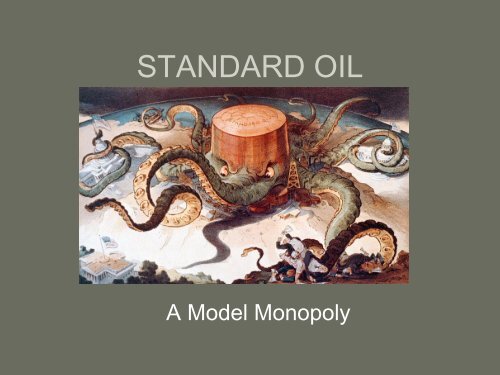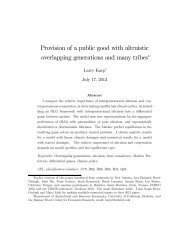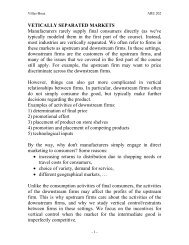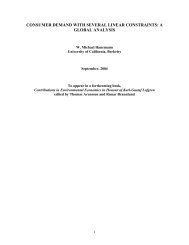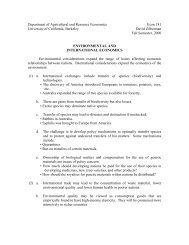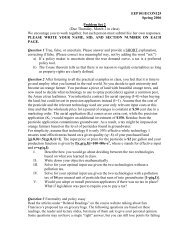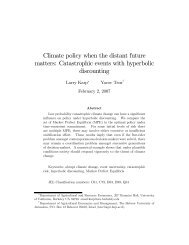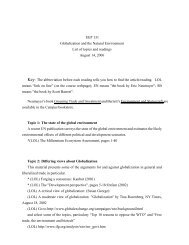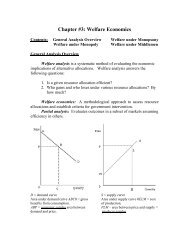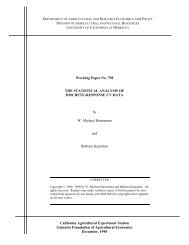STANDARD OIL
STANDARD OIL
STANDARD OIL
Create successful ePaper yourself
Turn your PDF publications into a flip-book with our unique Google optimized e-Paper software.
<strong>STANDARD</strong> <strong>OIL</strong><br />
A Model Monopoly
The Origins of Standard Oil<br />
• 1870: John D. Rockefeller and partners<br />
incorporate the Standard Oil Co. in Ohio<br />
• Soon began a systematic program of<br />
acquiring competitors.<br />
• By 1873, Standard had eliminated most<br />
competition within Ohio (1/3 of total US<br />
production), and began to spread into<br />
the Northeast.
Standard’s Methods<br />
Standard employed a variety of cut-throat<br />
strategies and tactics to undermine (and<br />
eventually acquire) its competitors. These<br />
included:<br />
• Undercutting prices<br />
• Buying oil barrel components<br />
• Railroad rebates<br />
• Corporate espionage and violence<br />
• Technical innovation (use of petroleum in<br />
operations)
Standard expands<br />
• Taking advantage of the financial panic<br />
of 1873, Standard was able to<br />
consolidate control of refineries in PA<br />
and NY<br />
• By 1878, Standard controlled 90% of all<br />
oil refined in the US.<br />
• Soon controlled most US marketing as<br />
well.
Standard’s Marketing Division - 1886
Vertical Integration<br />
• Standard began to expand its control of<br />
the oil industry by expanding beyond its<br />
traditional refining business into all<br />
stages of oil and gas production.<br />
• Acquired pipelines, railroad tank cars,<br />
terminal facilities and barrel<br />
manufacturing factories.
The Standard Oil Trust<br />
• 1882: An attorney for Standard suggests a<br />
new corporate arrangement where the<br />
stockholders Standard’s group of companies<br />
transferred their shares to a single set of<br />
trustees who controlled all of the companies.<br />
• In exchange, the stockholders received<br />
certificates entitling them to a specified share<br />
of the consolidated earnings of the jointly<br />
managed companies.
The Standard Oil Trust’s advantage<br />
• Whereas refineries had earlier tried to<br />
control output through informal<br />
agreements, incentives to cheat<br />
prevented these attempts from<br />
succeeding.<br />
• The trust model allowed Standard to<br />
function as a “highly disciplined<br />
monopoly.”
Effects of monopoly<br />
The Standard Trust was soon realizing<br />
massive profits due to:<br />
1. Effective control over prices.<br />
2. Increased economies of scale.<br />
3. The ability to further pressure<br />
suppliers and railroads into giving<br />
discounts and rebates.
Standard’s success<br />
• Standard used its massive profits to<br />
expand its operations into W. Europe<br />
and Asia.<br />
• Standard’s success at monopolizing the<br />
oil industry led to the establishment of<br />
trusts in over 200 other industriesincluding<br />
coal, steel, sugar, and<br />
tobacco.
The end of the Standard Oil Trust<br />
• 1890: Sherman Anti-Trust Act<br />
• In order to circumvent Federal law,<br />
Standard reincorporates as Standard<br />
re-incorporates as “Standard of NJ.”<br />
• 1911: The Supreme Court finds<br />
Standard of NJ in violation of the<br />
Sherman Anti-Trust Act, orders the<br />
dissolution of the trust. “Rule of reason.”
The aftermath<br />
• Standard was broken up into 33<br />
separate vertically integrated oil<br />
companies.<br />
• Standard’s breakup came during a<br />
period of transition in the oil industry:<br />
new supply (Texas), new demand<br />
(petroleum v. kerosene)
Where they are today<br />
• Standard’s former companies continue<br />
to make up a significant portion of major<br />
oil companies.<br />
• Exxon, Mobil (2), Chevron (7), Conoco<br />
(9), Amoco, and ARCO are all former<br />
Standard successors. (rank on Fortune<br />
500)


